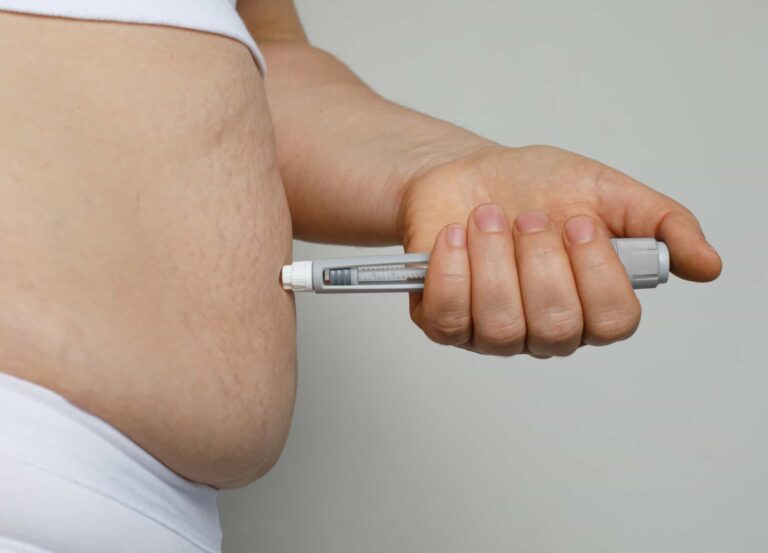Noninvasive body contouring treatments are a dime a dozen these days—you’ve got plenty of fat freezing, ultrasound skin tightening, and electromagnetic muscle toning options to choose from. But the latest way to sculpt your body, without going under the knife? Botox. Along with being an effective way to smooth out wrinkles on the face (as a quick reminder, it’s FDA-approved for use on frown lines, forehead lines, and crow’s feet), there are plenty of other uses for the popular injectable. It’s often used as a treatment for hyperhidrosis, migraines, and TMJ, to name just a few. And the list of alternative uses just keeps growing.
“Botulinum toxin has been used increasingly frequently off label in Asia, for its muscle-slimming effects in multiple body areas,” explains Dr. Y. Claire Chang, a board-certified dermatologist in New York City. This has gained more traction in the United States recently as patients [turn to] minimally invasive body contouring options.” Check out what doctors have to say about going under the needle for contouring—rather than wrinkle-fighting—purposes, below.
How it works
First and foremost, it’s important to understand how these types of Botox injections differ from those administered in the face. “Botulinum toxin is an acetylcholine release inhibitor that’s used cosmetically on the face to relax the muscles of facial expression and improve wrinkles,” says Dr. Chang. In this case, it works by blocking the signals that acetylcholine (a neurotransmitter) sends from the nerve to the muscle, telling it to move—but the neurotoxin doesn’t necessarily impact the muscle itself, adds New York City board-certified dermatologist Dr. Julie Russak. When you inject Botox into the face, the intent is to relax the muscles rather than atrophy or paralyze them. On a sliding scale of intensity—from relaxing to atrophying to paralyzing the muscle—the result of Botox’s effects is dependent on how much product is used and how deep the product is injected.
The type of injection used for body contouring is different from that used in the face: “This is an intramuscular injection, where the Botox goes much deeper into the muscle. You’re not trying to paralyze the muscle completely, but you are trying to atrophy it, more so than you would in the face,” explains Dr. Russak. (These muscle-atrophying effects, which simply means the muscles weaken due to inactivity, are also why botulinum toxin has been studied and shown to be effective for addressing muscle spasms and spastic paralysis as well as post-stroke spasticity.) An atrophied muscle is a thinner muscle, which in turn makes the area where you’ve injected it look slimmer and more defined.
In order to achieve these muscle-slimming effects, you’re going to need a pretty large supply of Botox, the costs of which can add up quickly. (For reference, one unit of Botox generally costs anywhere from $10 to $25.) Expect the same type of onset time frame as you would in the face, about two weeks—though it’s possible that full results may take up to eight weeks, since the Botox is being injected so deeply. But the effects last longer in the body than in the face, usually about six months as compared to three or four. As far as side effects go, some initial weakness or soreness in the area injected is possible, though this should be temporary and dissipate quickly. Below are a few common areas where “body Botox” is the most common and most effective.
The shoulders
Injecting Botox into the trapezius muscles—the shoulder muscles that run from the neck down to the middle of the back—can make shoulders appear slimmer and the neck more elongated, points out Dr. Chang. The other benefit? Similar to how Botox injections in the jaw can help improve TMJ and pain from teeth grinding (and yes, also make for a slimmer, more sculpted jawline), this can also help improve shoulder pain. After all, you are relaxing the muscle drastically, which will feel good if it’s constantly tense or tight. The exact amount of botulinum toxin needed varies, but Dr. Chang says it typically starts at about 40 to 50 units per shoulder (to put this in perspective, only about 10 to 30 units are used in the face).
The calves
Women complaining of overly bulky calves make up the majority of Dr. Russak’s patients who come in for this treatment; Dr. Chang adds that many of her Asian patients also want slimmer calves. The neurotoxin is injected into the gastrocnemius muscle (which runs down the backside of your leg, from your knee to your heel), either in the back or on the side. “We ask the patient to flex their calf and [we] inject the Botox into the area where the muscle is most pronounced,” explains Dr. Russak. Again, the amount needed varies based on the patient, the size of the calf muscle, and the desired effect. Dr. Russak says she usually starts with 40 to 50 units per leg, while Dr. Chang typically administers 50 to 100 units. You’ll see a slimmer calf contour after one treatment, though Dr. Russak points out the effects are even more noticeable after subsequent treatments. Worth noting: Whereas a quick tweak or touch-up is typically included in the initial price you pay for Botox injections in the face, this generally isn’t the case when it’s used in the body, notes Dr. Russak. And keep in mind that while results usually last about six months, patients who exercise their calves often may need more frequent treatments, says Dr. Chang.
Related: What’s the Difference Between Botox, Dysport, Xeomin and Jeuveau?
The thighs
Fillers are often used to smooth cellulite dimples, but they’re not the only injectables that can improve the look of your legs. Botulinum toxin can also be used in the quadricep, to reshape the contour of the thigh and minimize a frontal thigh bulge, says Dr. Chang. No, it won’t help with cellulite, but it will create the appearance of leaner, thinner thighs. This usually requires about 30 to 50 units of Botox per leg, and the same principle applies as it does for calves—if you’re constantly doing squats and lunges, the effects won’t last as long as the standard six months.
The risks
As with any type of injectable, finding an experienced injector is paramount, since there are risks involved. Be sure to ask if your doctor is experienced in these particular types of Botox injections. Possible complications include asymmetrical contouring or bulging of the muscle, if the neurotoxin isn’t injected in the right spots, as well as long-term muscle weakness, if too much is used.











